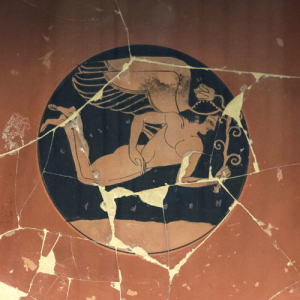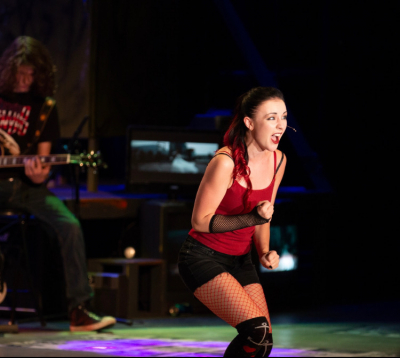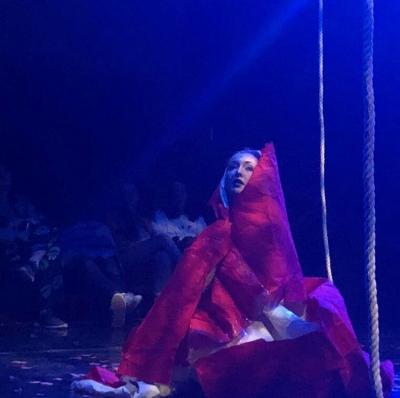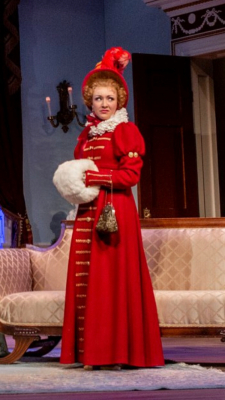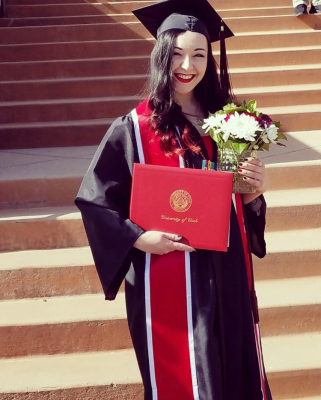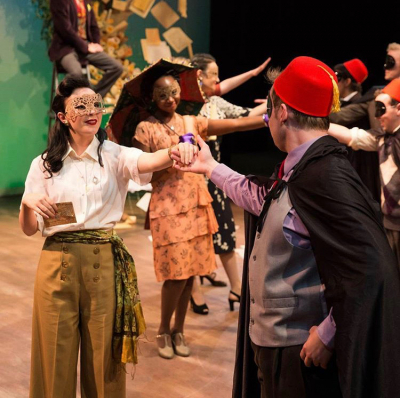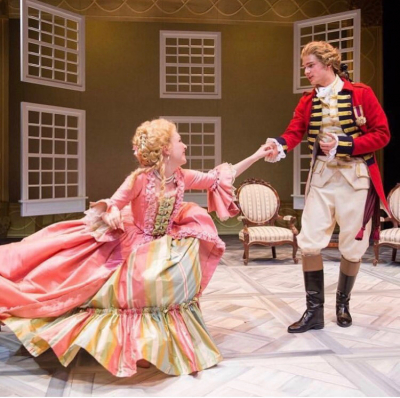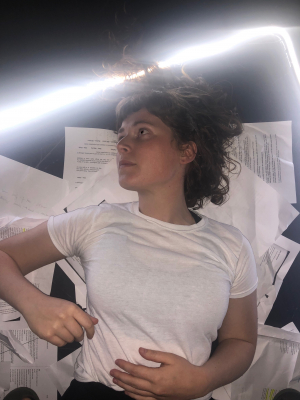Student Series: Francesca Hsieh
Violent Inspiration
Mary Zimmerman’s The Odyssey begins with the divine inspiration of a muse. Wouldn’t we all like a muse sometimes? Someone to just show up and take care of all our feelings of being stuck. I would like one right now as I try and write this blog.
Inspiration is really scary. Sometimes you will be brought on the seas of glory and artistic divinity. Sometimes you will feel mortal. You will feel endlessly, completely trapped in the day-to-day. You will lose loved ones. You will get lost. There will be war. You will not be able to find your way home.
Odysseus, the classic hero, navigates this struggle constantly throughout his journey, though perhaps in a more swashbuckling way than your average person living in 2019. (Stars - they’re just like us!) He conquers gods, kills monsters, controls the elements. He also sits and cries on an island for 8 years (we’ve all been there). He is thwarted again and again. He is betrayed by his own name. Sometimes he is in control of his story, masterfully and artfully detailing his struggles. Sometimes, it is in control of him.
But he does make it home! However, the classic image of homecoming – reunion with wife and child, floor littered with the bodies of dead men – is not the end of our story. Our show ends when Odysseus, following the prophecy of Tiresias, travels on foot far enough inland that he comes to a place where the children know nothing of the sea and there plants an oar. For the first time in our long, long tale of adventuring, Odysseus truly honors the gods. He lets himself be the vessel for the story, instead of resisting.
The world of The Odyssey is a violent place. There are sea monsters, potions that turn men to pigs, bloodthirsty gods out for vengeance, and storms that can keep you away from your family for 20 years. In a world alive with spirits that have agency over your life, it’s hard to ever feel safe. Our world is a violent place. There is constant war, political strife, mass shootings, and ideological conflict. In a world alive with anger, it’s hard to ever feel safe. It’s hard to ever feel at home.
The Odyssey is not an easily definable work. It cannot really be pinned down. One question, one statement of meaning cannot encompass all that it entails. (Believe me, I’ve tried.) But maybe there’s a reason that the muse keeps coming back. What if we stopped fighting our story? What if we honored it? In times of anger and violence we lose a shared world. What if we tried to get that back? What if we all knew of the sea?
By Francesca Hsieh, Assistant Director of The Odyssey
Student Series: Savannah Moffat
Eroticism and the Creative Process
All right everyone, I’m here to talk today about eroticism. Now, don’t run away or get too excited because I think the conversation will steer into a different direction than you’re anticip……..ating. (Shout out to all of the Rocky Horror fans out there.) Okay, I’m done with the bad jokes. Probably. Anyway, drawing on the thoughts of Anne Bogart in her book A Director Prepares, along with those of psychotherapist Esther Perel, I’m going to tell you how I think eroticism relates to the process of making theatre. Here we go!
After reading the chapter about eroticism in A Director Prepares and listening to Dax Shepard’s interview of Esther Perel (it’s on his “Armchair Expert” podcast and it is delightful, I’d highly recommend checking it out), I’ve come to the conclusion that eroticism is mainly about things like attraction, tension, and stimulation. If you think about it in sexual terms, that would mainly entail physical interaction, but when I think about eroticism in the theatre, all of those elements are represented in other ways. I also feel like using terms like these can help to take us out of the sexual realm that most people jump to when they hear the word “erotic.” When you’re looking at a play as an actor or director or even as an audience member and you’re trying to find where the eroticism lives, it may be helpful to ask yourself where is the attraction? Where is the tension? How do the characters stimulate one another? These kinds of questions can be incredibly helpful in keeping the play alive.
I really love how Esther Perel defines eroticism in her interview. She refers back to the original definition of eroticism, coming from the Greek word Eros, meaning life force. She consistently refers to eroticism as a sense of aliveness and vitality. Now of course she is talking about that in the literal sense of life, but I think it can also apply to the energy and presence of a play. A big goal that actors and directors have is to keep the play alive, to keep the audience’s interest and attraction alive. The best pieces of theatre I’ve seen are those that seem to be living and breathing, where the energy in the space is palpable and the stakes are high. Eroticism is key to creating and maintaining this energy. Anne Bogart focuses the first big chunk of her chapter on the idea of a play or a moment “stopping you in your tracks” and then continuing to hold your attention as it slowly reveals itself. Learning how to find and create moments that will grab an audience’s attention and then continue to keep them on their toes is one of the main goals of theatre professionals. Keeping the erotic tension between the actors and the audience is imperative. Here again, nothing sexy is going to go on between the actors and the audience, but the excited and charged energy between everyone in the theater needs to remain through the whole show.
I mentioned something in that last bit about a play slowly revealing itself, and I want to dive into that a little bit. I mentioned earlier that eroticism involves tension, and that is key to every play. I mean, who wants to sit through a two-hour show where everything just goes perfectly? Playing with the concept of eroticism in this sense can be a huge tool in the actor’s belt. Knowing when to release and (more importantly, in my opinion) when and how to hold back is a key skill to have as an actor, and it’s something that a director needs to keep an eye out for. It goes back to the tried and true idea of using different tactics. If an actor figures out how to manipulate the attraction between themselves and another character, and especially if that other character is doing the exact same thing back, the interactions are bound to be much more interesting. Anne Bogart has a quote in her book that says, “When you feel ten in your heart, express seven.” For example, I have always found it much more interesting when someone fights back tears instead of bursting out crying, or when someone threatens someone else calmly and softly rather than flying into a rage. This technique of balancing eroticism leaves a lot to question and is necessary to keep the audience intrigued through the end of the play.
I’ve touched on this a bit, but eroticism lives throughout the entire process of making a play. It probably comes as no surprise that erotic tension builds up between actors in a rehearsal room. (Again, maybe sexual, but we won’t get into that.) Actors tend to be emotionally intuitive and connect with people really quickly, and that kind of connection can lead to some really exciting moments on stage. As important as it is for actors to feel that erotic tension amongst themselves, it is also important for that kind of energy to develop with the director. As I’m sure many of you have experienced, there are moments in a rehearsal room where it feels like there’s an electrical charge running through everyone. This typically happens when the actors involved along with the director are creatively open and vulnerable and willing to try different things and are both in sync and challenging one another at the same time. Now this doesn’t happen all the time, but when it does, it’s magical, and it’s a perfect example of erotic tension! There’s nothing overtly sexy about these moments, but the connection between everyone in the room is exciting and motivating and yields beautiful results in the final product. I look at it as a kind of chain, if the actors and directors find some kind of erotic tension amongst themselves, and find moments of eroticism in the play, then that energy can carry on to the audience.
Perhaps my favorite thing that Esther talks about are two basic human needs: the need for stability and the need for change. This relates directly to what Anne Bogart talks about in accordance to eroticism within a play. A good play starts with a moment of imbalance, something to set both the characters and the audience on edge, and this moment creates the all-important sense of attraction (so it’s very important to get this moment right). After that, the rest of the play essentially deals with how to get back to a state of stability. I love that as humans we crave both of these things, and good theatre is so exciting because it contains all of that in a couple of hours. Plus, you can live and breathe within this world of imbalance without it directly affecting your life. Whether they know it or not, this sort of progression is exactly what an audience wants. They want to be taken out of their comfort zone for a minute, be exposed to some sort of conflict, and then hang on for the ride as the characters find some sort of stasis. It’s the push and pull of life, and if actors and directors can find and manipulate moments using a sense of eroticism, they’ll be golden.
There are probably a million more things I could say about this topic and what these two wonderful women had to say about it, but I’ll spare you the pages. With that said though, I would highly recommend reading Anne Bogart’s chapter on eroticism as well as listening to the podcast with Esther Perel and see what conclusions you come to! Thanks for reading!
by Savannah Moffat, Actor Training Program class of 2019
Savannah Moffat is a recent graduate from the University of Utah Actor Training Program. She was most recently seen as Lydia in The Rivals at the University of Utah. Other credits include Miss Bennet Christmas at Pemberly (Anne DeBourgh) at Pioneer Theatre Co., American Idiot (Whastername) with Good Company Theatre, The Musical Comedy Murders of 1940 (Helsa) at the Grand Theatre, and Love’s Labour’s Lost (Rosaline) at the University of Utah. She absolutely loved her time in the ATP and can’t wait to see where future theatre adventures take her!
Student Series: Emily Nash
Of all the gifts the ATP gave me, the ability to create my own work is one of my most cherished.
My formal introduction to composition and original work began my 2nd year of undergrad. Under the guidance of our fearless faculty mentor, myself and nine other students devised a show almost entirely comprised of material we’d generated via composition prompts. The process at times felt erratic and tangential, but every moment of it served to texture the work, some composition pieces presenting literally, some living in the shadows of the piece.
I can say with complete confidence, it was unlike any other way I’d worked before.
Time, plenty of experimenting, and lots of good old fashioned failures have carried me beyond that initial project and into my own work. Over the years my text collection has deflected from that of a classically trained actor to reflect an emerging, eclectic devisor. But in all my menagerie of workbooks, I have yet to find a golden formula detailing how to fold composition pieces into larger works. I’m eons away from establishing my own methodology, but in articulating how I’m beginning to approach this task, the vocab that interests me most is connective tissue and constellations.
Running parallel to my last year in the ATP was my massage therapist training, and with it, my intro and subsequent fixation with connective tissue. Connective tissue presents differently depending where in the body its found, but it’s fundamental function remains the same: it connects tissues. Every muscle, bone, organ, and nerve is embraced and unified by connective tissue. It literally holds us together. In approaching original work, I think our job as devisors can be taking the bits and bones of composition pieces and laying down the connective tissue to unify a series into a whole. Some bones are more prominent than others (in bodywork we call these bony landmarks), but it’s the deeper systems that provide the organism its structural integrity. Visible or buried, each piece works in tandem to aid the function of the whole. An example of a work I feel lives in this realm is the National Theatres Jane Eyre- there are moments where composition work bubbles to the surface, but more than composition I see a body at work.
On the other hand are constellations. If each composition is an independent point of reference, a star, our job is to receive a field of light and selectively chart a path. I love the sentimentality of star informed navigation, that constellations have a sense of reorientation and forward motion. They take us somewhere we were not. Frantic Assembly’s Lovesong, a relationship depicted over a collage of composition work, is a show that presents like a constellation to me.
The commonality I’ve arrived at for these metaphors is that it takes an incredible amount of pressure to create bone or star. The products and processes vary, but the pressure is always exquisite. The same can be said for creating new work, whether it resemble bodies or constellations. It’s the capability to manufacture and thrive under pressure that I carry into these next chapters of my career. I’m grateful for the lessons I’ve learned and those I have yet to encounter, but for now it’s time to get back to work. Pressure’s on.
by Emily Nash, Actor Training Program class of 2019



